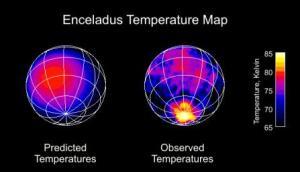Hot Spot found on Enceladus

The CIRS instrument released this view of Enceladus. The image on the left is based on a model assuming a sub-solar temperature of 80 Kelvin, then cooling as you approach the terminator. The view on the left is the brightness temperatures actually measured by CIRS at wavelengths between 9 and 16.5 microns. The equatorial temperatures were as expected, again with temperatures around 75 Kelvin. Surface temperatures then cool to around 65 Kelvin as you approach the south polar region. However, in the south polar region, the temperature dramatically increases, to brightness temperatures of around 85 Kelvin, 15 degrees warmer than expected. The detector footprint at this distance was 25 km. Color temperatures from this data reveal small regions on the surface at well over 110 Kelvin.
The temperatures found in the south polar terrain are too warm to be caused by heating from sunlight alone, though exotic sunlight-trapping processes have not been ruled out. This means that heat from Enceladus' interior is escaping in the south polar region. The temperature would also be warm enough to produce evaporation of water ice at the surface, consistent with UVIS and MAG measurements of a concentration of Enceladus' atmosphere in the region.
This data makes Enceladus only the third body in the solar system (including the Earth and Io) where heat escaping from the body's interior has been found.


0 Comments:
Post a Comment
<< Home